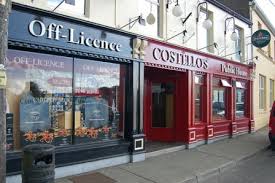Monday 30th July 2012
The Rich of Ireland hiding 250 Croke Park’s of cash outside the country?


As the wealthy get richer, the poorest get poorer and continue to bear the brunt of the bankers’ mistakes,
Imagine a million dollars. Imagine it sitting on a seat in Croke Park. Imagine every seat in the stadium had a million dollars wrapped and stacked on it. Altogether, that would be upwards of $82bn. Now, imagine 12 Croke Parks, each seat similarly decorated with money. Now, you’ve got a trillion dollars.
Now multiply that by 21. We’re looking at over 250 Croke Parks, each holding $82bn. Now, unless the batteries on our calculators are dodgy, we’re looking at something approaching the amount of money hidden offshore by the super-rich in 2010.
The figure of $21trn is the conservative estimate (it could be up to $32trn) in a report published last week by the Tax Justice Network (TJN). The research for the report was done by the former chief economist of McKinsey, a consulting firm that’s hired by major corporations and governments.
The research is based on information drawn from the IMF, the World Bank, the Bank of International Settlements and various central banks. And this is just financial wealth, bankable lucre — not including property. The research by TJN identified a black hole in the world economy, where increasing amounts of resources are sucked up by those already so rich they’ll never live to spend a fraction of that money.
Those young semi-hippy folk, who call themselves occupy this and occupy that, are of course very naive and unfocused. And, as it happens, just about spot on, when they identified the problem — the massive imbalance in the allocation of resources. There really is a greedy, wasteful one per cent, who are allowed to hoover up an enormous amount of what we produce. And an army of professionals who benefit from servicing them.
Now, you might imagine that offshore money is hidden using the favoured method of corrupt Irish politicians and officials — flying to Jersey or the Isle of Man, with envelopes full of cash stuffed down their Y-fronts. And opening accounts using the name of their granny’s poodle.
Not quite, though the morality of it is similar. These offshore trillions are managed by an array of private bankers, who route their clients’ money electronically.
And this isn’t just a lot of money. This is a major portion of the world’s wealth. The GDP of the USA is about $15trn. Therefore, the minimum amount hidden offshore, $21trn, is equivalent to the entire American economy. Plus the Japanese economy.
But, if this is true — how come we don’t see some tell-tale signs? Well, we do. Last week, as it happens, a committee of the US Senate reported on the activities of HSBC, the British monster bank — in every sense of the term.
For some years, HSBC, Europe’s biggest bank, has been channelling offshore the hot money of assorted criminals and dictators, as well as the swag taken by the corporate sector. This allows the criminals and dictators and various corporate chaps to go about their business, whether in business class or private jets, without worrying that some grumpy airport security type on minimum wage might pat them down and find a chunk of money.
Mexican drug gangs, for instance, ran $7bn into the US economy in 2007 and 2008, using a subsidiary of HSBC. More than 52,000 Mexican client accounts were accommodated by HSBC in the Caymans. Over a period of seven years, more than $19bn was channelled from Iran. Money from the Middle East and Asia, associated with terrorism, was similarly transferred into hidey-holes.
(Couldn’t happen here, you say? Remember an Irish bank’s involvement in back-to-back Cayman manoeuvres with a certain Fernando Pruna, later convicted of drug dealing? Moriarty Report, Part 1, page 502.)
The bulk of the $21trn, of course, is money accumulated quite legally, albeit depending on coercive business methods, manipulated tax regimes and the occasional bribe.
The extent of Irish wealth hidden within such funds is undocumented, as yet. For too much of the time, we fret about the detail of what’s happening — minor shifts in GDP, a decrease or increase in a deficit. The rise of one transient politician, a clone of countless political place-holders, is analysed as though it meant something.
The bigger picture includes a layer of super-rich, with other layers of cronies and helpers. And a financial sector that has taken on a role that’s more significant than that of any government.
The collapse of Lehman Brothers affected more lives than the rise of Barack Obama. The collapse of Fianna Fail was no big deal. Fine Gael and Labour stepped briskly into their shoes. The collapse of Anglo Irish Bank, however, destabilised the country.
Banks used to be utilities, facilitating the flow of credit. They are now power centres with their own interests — separate from and often opposed to the interests of the citizens.
At which point it’s not just about power and greed — such bankers become the enemy within. British bankers were recently caught falsifying interest rates that affect the rest of us. It’s not long since Irish bankers were caught falsifying account details, to help clients defraud the Revenue of billions. They got a slap on the wrist. Many bankers are reluctant to indulge in actions that are questionable, probably dodgy, or unmistakably illegal — but if they chicken out some competitor would step in, so they do what they need to protect market share. And they know any consequences will be minor and the rewards immense.
Quite openly, with no fear of chastisement, the wealthy transfer ownership of assets to spouses. They move assets to where they can’t be touched — sometimes they do this illegally. They transfer residency to the UK, to benefit from relaxed bankruptcy laws.
Less openly, politicians are persuaded to rejig legislation. Tax liabilities are magicked away. Money is run through several entities before going offshore.
Deferential politicians give a bank guarantee here, a Finance Bill there. Shane Ross TD argued in the Dail recently that the banks get “the same deference today as they were given in 2008”. He denounced their “absolutely unacceptable input into legislation”.
Social Justice Ireland, using the latest CSO figures, report a 4 per cent increase in disposable income for the top 10 per cent. And an 18 per cent drop in the income for the bottom 10 per cent. And that’s not counting the hidden money.
Having wrecked their financial system, the wealthy and their bankers continue to make big bucks, and they trust the politicians to fix things. And the politicians asset-strip the great majority of us, to plug the holes in the system. They cut deeply into those at the bottom, while insisting on preserving the wealth of the elite — sometimes known as bondholders.
A couple of weeks back, the IMF dropped in and instructed the Government that they must advance on two fronts. First, they must cut welfare benefits and medical cards. And they must “strengthen” the banks. They need to “enhance asset quality” and “regain profitability”.
They demand we chop unemployment benefit, to force the unemployed to take jobs that don’t exist. And simultaneously do whatever is needed to help the banks restore immense profits and sustainable bonuses. “Jump,” said the bankers. “How high?” said the politicians.
Male’s in Ireland, over 50’s, overpaid – Power drunk & they still rule Ireland



Those responsible for our downfall remain unchallenged,
‘Official Ireland is predominantly male, predominantly over 50 and predominantly people who earn over €100,000. For the most part, it includes the speakers at the MacGill summer school in Donegal and those that attend it.”
Every single inquiry into public life that we have had in this country over the past 15 years has come down to one singular thing. The operation of power by Official Ireland. The political tribunals, the church scandals, the police inquiries, the hospital failures and the banking crisis were ultimately about the abuse of power.
Those abuses were enabled and facilitated by those who never shouted stop but punished those who did.
Official Ireland is characterised by the sameness of people in positions of power which means a uniformity of decision-making. This closed-minded conformism dismisses and belittles anyone who opposes the group consensus. These awkward people with alternative views.
The Carragher Report and the Nyberg Report both used the same word to explain why catastrophic failure occurred in the two very different institutions of RTE and the Irish banks.
“There may have been a strong belief in Ireland that contrarians, non-team players, fractious observers and whistleblowers,” the Nyberg Commission noted, would be informally or publicly “sanctioned or ignored, regardless of the quality of their analysis or their place in organisations”.
No official acknowledgment has been given to the whistleblowers who endured to tell the truth. People like Frank Crummey, Joe McAnthony, Padraig Mannion, Joe Murray, Sheenagh McMahon, Patrick McGuinness, Eugene McErlean and others should be thanked for the service they have given to this State.
Official Ireland ostracised heroes like the social worker Frank Crummey, who confronted the abuse of children head on. Joe McAnthony, the Sunday Independent investigative journalist who first uncovered payments to politicians back in 1973, also suffered. A troublemaker whose persistence was rewarded with emigration.
“My life was pretty much over as a journalist. Everything I worked on was closed down,” Joe said in an interview some years ago. “Nobody would hire me. I had four children. So we had to go. I was essentially expelled from Ireland.”
That’s what Official Ireland has done to individuals who have tried to speak the truth. To avoid rather than confront. The refusal to recognise the fundamental difference between right and wrong which poisons public life. Excuses are made for erroneous behaviour, often to protect a reputation.
It still happens. We still build safe consensus on particular subjects. Three examples.
According to the polls, Sean Gallagher was 13 per cent ahead before the RTE Frontline programme aired three days before the presidential election.
Some 900,000 people watched that programme and many changed their mind because of Pat Kenny’s line of questioning that night.
The agreed analysis after the debate was, well, it was the way Gallagher used the word envelope. It was the way he reacted. It was his fault. That was the official line, the groupthink. Then the Father Reynolds episode happened and this forced earlier assumptions to be questioned more forcibly.
Gallagher’s complaint was upheld by the Broadcasting Authority of Ireland, which found that there was a “lack of objectivity” by Kenny.
Anne Harris wrote an article in the Sunday Independent a month ago alleging media interference by the newspaper’s biggest shareholder. The article related to Denis O’Brien’s borrowings from Anglo Irish Bank.
Not a single newspaper, or other media outlet, picked up on that story. Official Ireland decided that this was an internal boardroom battle within Independent News and Media. And the attitude ‘sure, that’s the Sunday Independent’.
The last example. Two-thirds of Ireland’s population, some 2.8 million Irish citizens, are under 45. This lost generation is disproportionately bearing the brunt of austerity. The CSO revealed this week that the number of those under 24 who are unemployed could fill Croke Park to capacity. One in two young men are unemployed. One in 10 men between 19 and 29 have left Ireland in the past 10 years. The rate of youth unemployment rose by 74 per cent since 2006.
It is this generation who also have the greatest burden of mortgage debt. Central Bank figures show that 18,193 mortgages have arrears of more than 90 days, and 59,437 mortgages have arrears of over 180 days. Another 38,658 have restructured their mortgage by moving to interest only or reduced payment.
None of these people are Official Ireland. They do not speak at summer schools or grace the Marian Finucane panel on a Sunday morning. We do not hear their voices.
Membership of the State consensus includes those who, for the most part, enjoy economic advantages such as intact pensions, mortgage-free houses, secure contracts and disposable income.
These mostly male, middle-aged decision makers are responsible for the collapse in the first place because they never shouted stop.
Elaine Byrne is the author of ‘Political Corruption in Ireland 1922-2010, A Crooked Harp?’ published by Manchester University Press, 2012 See http://www.elaine.ie/book/
Ireland’s food and drink industry vital for jobs, says Ibec group



30,000 new jobs could be created by the Irish food and drink industry by 2020, according to a new report by Food and Drink Industry Ireland, the Ibec group that represents the food industry.
According to the report, sharing the Harvest: the Food and Drink Sector Jobs Dividend, 230,000 people work in the sector, representing one in eight jobs.
The report argues that, in contrast to most other manufacturing industries in Ireland, the food and drink sector buys most of its inputs and services from within the Irish economy.
Some 76 per cent of the industry’s expenditure is spent in Ireland, compared to an average of 30 per cent for other manufacturing industries, according to the report.
“This reflects a strong Irish-based supply chain which is far more likely to retain jobs and investment per euro spent in the wider economy.”
The agri-food sector has a “substantial GNP-generating effect”, according to Food and Drink Industry Ireland, “retaining profits in Ireland unlike other sectors where profits are repatriated abroad”.
Commenting on the findings of the report, FDII director Paul Kelly said that Ireland’s food and drink sector “is deeply embedded in the Irish economy, which means that an increased focus on food will drive growth in the wider economy as well as in the sector itself”.
Highlighting the need for public policy to be aligned with the needs of the sector, he underlined the need for a sustainable supply of cost-competitive raw materials and the implementation of the proposed grocery code immediately following the enactment of primary legislation.
He also stated the imperative to influence the redevelopment of the EU state aid regime for the post-2013 period.
New gene class could potentially prevent epileptic seizures


Irish researchers have discovered a new gene that could offer new hope to epilepsy sufferers.
Irish researchers have identified a new gene class which they say could potentially provide new treatment that would prevent epileptic seizures.
Researchers at the Royal College of Surgeons in Ireland, clinicians at Beaumount Hospital, and experts from Madrid’s Cajal Institute say that the new class of gene, called MicroRNA, is instrumental in the control of protein production inside cells. They found much higher levels of one particular type of this gene (microRNA-13) in the part of the brain that causes epileptic seizures.
The journal Nature Medicine has published the team’s paper, which outlines how scientists used a new type of drug-like molecule called antagomir which seems to lock onto the microRNA-13 gene and remove it from the brain cell – and, by doing so, prevent epileptic seizures.
“We have been looking to find what goes wrong inside brain cells to trigger epilepsy. Our research has discovered a completely new gene linked to epilepsy and it shows how we can target this gene using drug-like molecules to reduce the brain’s susceptibility to seizures and the frequency in which they occur,” said the senior author of the paper Prof DavidC Henshall,of the Department of Physiology and Medical Physics at the RCSI.
Approximately 37,000 people in Ireland are affected by epilepsy and, of those, one in three continue to experience seizures despite being prescribed medication.
Mayo town Ballinrobe offers to exchange punts for goods & services


Shopkeepers in Ballinrobe, Co. Mayo, are going back to the future by accepting old Irish punts as payment for goods and services.
Just over a decade ago the euro replaced the punt, but the Central Bank estimates that more than £300m is still outstanding.
Shoppers in Ballinrobe will get an opportunity to put that money to good use, with the Spend Your Punts campaign.
They will be offered an exchange rate of £1 for €1.20 and change will be given in vouchers.
It comes after a similar campaign was run in Clones, Co. Monaghan. More than 40 local businesses have signed up for the scheme.


 He made his fortune as a tax expert at Barclays Bank and now sits on the board of Brazilian bank BTG Pactual, splitting his time between Sao Paulo and North America.
He made his fortune as a tax expert at Barclays Bank and now sits on the board of Brazilian bank BTG Pactual, splitting his time between Sao Paulo and North America.
